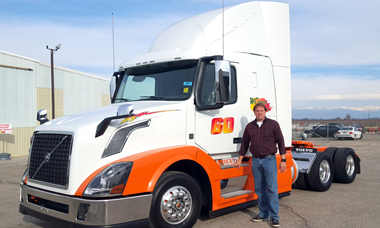Farmers could face yet another trucking challenge next year as dealers are running out of models that meet California’s increasingly strict air quality standards. A regulation at the Air Resources Board (CARB) will trigger new sales requirements in January to curb local air pollution, and dealers are already raising alarms about low truck inventories, skyrocketing prices and forcing hauling companies to purchase new vehicles from other states.
The Heavy-Duty Engine and Vehicle Omnibus Regulation is a key component of CARB’s strategy for cutting emissions from cars, trucks and other mobile sources. CARB established the standards in 2013 to reduce nitrogen oxide (NOx) emissions from diesel engines by 90%, converting it in 2021 from a voluntary, incentives-based approach to a regulatory mandate on manufacturers.
It specifically targets the state and the nation’s most polluted regions—the San Joaquin Valley and along California’s major export hub stretching from the Inland Empire to the ports of Long Beach and Los Angeles. Air districts for the two basins are relying on the rules to reduce NOx as well as ozone and fine particulate matter (PM2.5) emissions by 2031, after several years of failing to meet federal air quality standards. About 67% of the state’s population, or 26 million people, live within high ozone and NOx concentrations and most are in low-income or disadvantaged communities. Heavy-duty trucks are the largest source of NOx emissions.
As with CARB’s regulations to advance zero-emission cars and trucks, the omnibus regulation enforces the reductions through sales mandates. In 2024 dealers must ensure that only 45% of their truck and bus sales involve legacy diesel engines. It ratchets down to just 25% in 2025, before zeroing out completely in 2026. CARB has set a NOx threshold for the clean engines at about half of what EPA regulations require, according to a sales manager for municipal waste trucks in Oakland.
CARB staff are in the process of amending the regulation to provide more flexibility, while still holding manufacturers to the same overall emission reduction levels.
The amendments were part of a deal the Newsom administration struck in July with major truck and diesel engine manufacturers, an effort to encourage those companies to produce enough medium- and heavy-duty models to meet CARB’s aggressive climate mandates.
One alternative to the existing omnibus requirements is to allow for 10% of the sales in 2026 to be legacy engines. Another option is to bump the allowance to 60% for 2024 and 2025 but only for the medium range of heavy-duty engines, while capping sales of the largest engines at 15% and 8% respectively.
 Chris Shimoda, California Trucking Association
Chris Shimoda, California Trucking AssociationGovernor Gavin Newsom touted the deal as “showing the rest of the country that [California] can both cut dangerous pollution and build the economy of the future.” Jed Mandel, president of the Truck & Engine Manufacturers Association, noted the coalition has “secured needed lead time and stability for manufacturers and agreed on regulatory changes that will ensure continued availability of commercial vehicles.”
Under the Advanced Clean Trucks rule passed in 2020, CARB is requiring that 6% of all truck sales are for zero-emission models starting in 2024, while the Advanced Clean Fleets rule is also phasing in new purchasing requirements in 2024.
CARB turned down an Agri-Pulse request to respond to stakeholder concerns about the omnibus regulation. Instead the administration issued a press release announcing it has already surpassed the 6% goal by 1.5%, with 7,639 ZEV trucks sold in 2021 and 2022, the most recent numbers available. The statement did not mention low-NOx truck sales.
Dealers are warning the supply of those trucks has bottomed out due to high demand, supply chain constraints and lingering pandemic-related delays, and that the omnibus requirements may lead some to pause all sales until 2027, when the regulation aligns with the less-stringent federal EPA standards.
During a CARB hearing Friday on the omnibus amendments, Mandel again applauded the agreement with the Newsom administration but stressed its limits.
“While those amendments won't fully ameliorate the potential for limited availability of products in California, they will implement changes that allow for increased availability of medium and heavy-duty engines and vehicles,” he said.
TEC Equipment, the largest dealer on the West Coast, is not concerned about the steady migration to ZEV technologies but it is worried about the “velocity of which we're being pushed to get there, particularly as it relates to the low-NOx requirement,” according to Adam VanderBee, a regional sales director. While engine manufacturers have been working toward EPA’s 2027 low-NOx mandate, he called CARB’s 2024 rule impossible to reach.
VanderBee noted that next year manufacturers will offer a motor that is slightly above CARB’s NOx threshold. Since it would not qualify as low-NOx, however, a carbon offset provision in the omnibus regulation would require TEC Equipment to sell one electric truck for each of the diesel engines. Yet battery-powered semitrucks are still in their infancy stage of development, with just 173 registered nationwide, and they are “unrealistically expensive” and weigh four times more than a diesel rig, he argued.
It’s easy to be “in the know” about what’s happening in Washington, D.C. Sign up for a FREE month of Agri-Pulse news! Simply click here.
The omnibus regulation is already leading to lost sales. According to the California Trucking Association, the drop in truck availability is as high as 90% at some dealerships. Chris Shimoda, association senior vice president of government affairs, said that statistic is in stark contrast to the initial staff analysis of the regulation’s potential economic impacts, which forecasted a slight decrease in vehicle sales.
 Mark Woods, Wildwood Express Inc.
Mark Woods, Wildwood Express Inc.“That's clearly not come to pass, said Shimoda. “More needs to be done.”
Michael Tunnell, senior director in environmental affairs at the American Trucking Associations, said the supply shortage has driven a spike in prices that is seven times greater than the CARB projection.
The cascading economic impacts could trickle down to vulnerable communities in the Central Valley. Affinity Truck Center in Fresno sells Volvo and Mack trucks but has only natural gas vehicles to sell for one brand and only 37 legacy diesel trucks from the other, compared to 450 sales last year. President Kim Mesfin warned of the impacts to the Punjabi Indian drivers who are her primary customer base.
“They would be forced to buy outside of California, yet drive back into California, impacting emissions in no way for the positive,” said Mesfin.
Several motorcoach, motorhome and industrial crane dealers shared similar frustrations, and the regulation poses indirect impacts to agriculture as well, according to Mark Woods, vice president at Wildwood Express Inc. The family-run operation has a 60-truck fleet in Fresno County and hauls citrus trees, drip irrigation components, cardboard pallets and other supplies for major packing houses throughout the state. Woods said that “quite a few customers” have been asking about the trucking company’s availability and how it will manage to find new trucks next year.
“These companies are really in fear of what's going to happen to us and what's going to happen to their industry without our trucks,” he said.
Environmental justice advocates, on the other hand, chastised the deal with manufacturers. Bill Magavern, policy director at the Coalition for Clean Air, argued the proposed amendments would allow more dirty diesel engines in California. Yet he urged CARB to finalize and enforce the changes as soon as possible to prevent more toxic diesel exhaust.
Tunnell countered that “the success of the omnibus regulation depends on the sale of new trucks,” yet it is doing the opposite by disrupting the supply of new trucks into the market.
For more news, go to Agri-Pulse.com.


